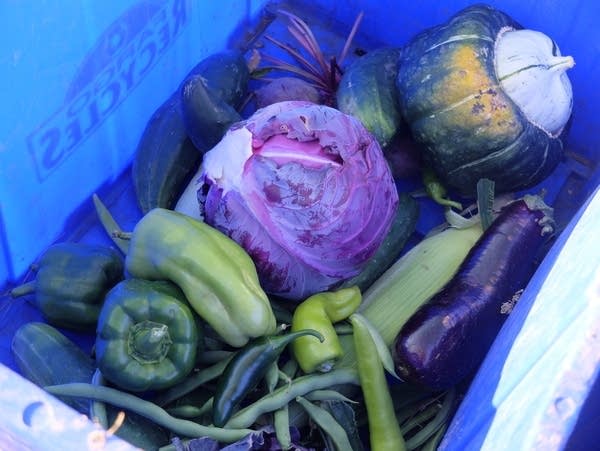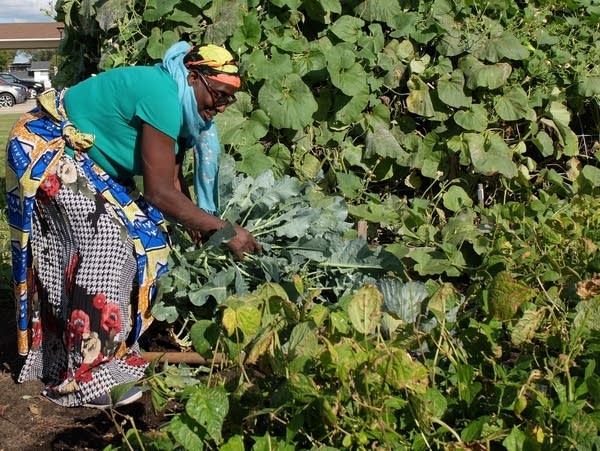Over 14 years, Fargo gardens grow community

Go Deeper.
Create an account or log in to save stories.
Like this?
Thanks for liking this story! We have added it to a list of your favorite stories.
Simeon Bakunda’s first gardening season in Fargo was memorable — mostly for how it ended.
It was 2010, and he had been in North Dakota a few months, and spent the summer working with Nola Storm and her Growing Together project, the community garden she helped start in 2005.
“The frost came and killed everything off, and so we had to clean up the garden,” Storm recalled . “And he gets out of his car and looks at the garden and goes, ‘So, this is how it ends.’”
“Oh my goodness! I can’t forget that,” Bakunda said, picking up the story. “That’s been a sad memory, but a good one, too.”
Turn Up Your Support
MPR News helps you turn down the noise and build shared understanding. Turn up your support for this public resource and keep trusted journalism accessible to all.
But Bakunda came back — and has spent the eight summer since then gardening with Growing Together.
“Through the community garden I made many friends. I got to know how to grow vegetables around here,” Bakunda said. “And I keep learning. We kind of complete each other. We learn from each other.”

Bakunda learned about short growing seasons, and he taught Fargo residents about African eggplant varieties. Late last month, he and Storm joined about 50 of their gardening colleagues to harvest and clean up one of Growing Together’s six plots, just off the interstate in Fargo.
For nearly 15 years, these gardeners — longtime Fargoans paired with more recent arrivals from around the world — have had a significant influence on what’s grown in the project’s gardens around town. Pumpkins were exchanged for more kinds of squash, including snake gourds. And as they’ve influenced each other’s palates, they’ve built relationships among the crop rows that gardeners say are equally lasting.
Those connections are one of the reasons Nola Storm and her fellow longtime Fargo resident Jack Wood founded the garden project with the help of local churches in 2005. Storm was teaching English to refugee families when she realized a shared garden might help those families feel more a part of the community.
It started with eight families and a handful of volunteers, she said — and has grown since then to include about 150 families who garden at six locations.
“Last year in our gardens, we produced 65,000 pounds of food,” Wood said. “It's all shared with the gardeners. They need to work 16 hours, and then you're considered a full-share member.”
The members take home tubs of veggies like squash, carrots, corn, eggplants, tomatoes.

Jack Wood is known as the tomato man. He grows 60 varieties of heirloom tomatoes — from seed — every year. More than 10,000 plants are started each spring in basements and sunny windows across town. Over the years, the program has added three greenhouses to help the plants get a good start.
And as the seedlings move from gardeners’ basements to their windows to the program’s greenhouses, the people cultivating them have created a tight-knit community among the tomatoes and snake gourds.
Goma Nepal uses those snake gourds, which are 3 feet long and hang from vines supported by arches, in curry dishes from her native Bhutan. Gardening is part of her culture, she said, but she lives in an apartment, so it’s something she couldn’t do before joining the program.

Having access to vegetables is a big benefit of her work on the plots — but thanks to the time she spends at the community garden, she has lots of new contacts in her phone, too.
“When you come week after week, you build relationships with each other. So, there's people you look forward to seeing,” said Storm.
One of those people Storm looks forward to seeing in Rosaline Swarray, who helped her start that first garden.
"She's just like a sister to me now," said Swarray, who worked alongside several family members, sorting vegetables into tubs for shareholders to take home in late August. She moved to North Dakota as a refugee from Liberia 14 years ago. But this garden has made Fargo feel like home.
"My friends from like other cities say, 'Rosaline, that is just a little town! Come over!'” she said. “I say, ‘No, I like it here’ because I have my family. Everybody in this garden, we love them."
As Swarray talks, her friend Agnes Cole nods her head. She’s also a committed gardener.
“Anywhere I go I love to garden,” Cole said. “[It] feels like home. When we come here, we do this, we are home.”
The garden helps feed three generations of Swarray’s family, she said. And that helps save money, too.
“Me and my sister, we used to rent a car to go down to Minneapolis to the farmers market to buy food,” she said. “But since we started this garden, [I’ve saved] my money. [And] I help my family back in Africa.”
As the gardens die every fall and the gardeners gather to clean up from the harvest, the friendships that have begun here are lasting, said Storm. They’ve helped break down barriers of culture, and language.

“If you're working in the garden, and doing a task together, and then you see each other out in public,” she said. “And you're like, 'Oh my gosh, hi! You're my friend. I still can't have a conversation with you, but you're my friend.'”
The Growing Together project is garnering some attention beyond Fargo. It won a national award last year from the National Council of Garden Clubs, and it's serving as a model for other gardens around the region — for the ways it creates community around growing food.




